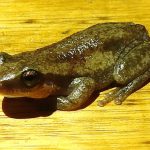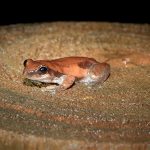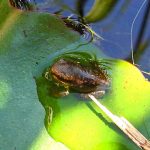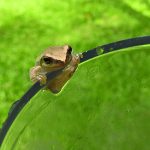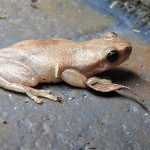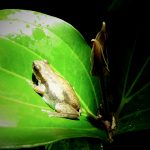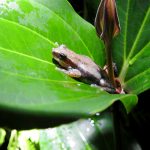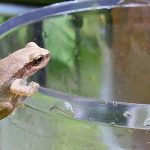DESERT TREE FROG
The Desert Tree Frog is a fascinating creature that thrives in some of Australia’s most challenging environments. Despite its name, the Desert Tree Frog is not strictly arboreal and often spends a lot of time on the ground or in low vegetation.
Typically measuring between 30 to 45 millimetres in length, it has a smooth, pale brown to reddish-brown skin, often with darker spots or mottling that helps it blend seamlessly into its arid surroundings. Its underbelly is usually a lighter cream or white colour. One of its most distinctive features is its large, expressive eyes, which give it a somewhat curious appearance.
This resilient frog is found across a broad range of habitats in northern and eastern Australia, from the arid deserts to the tropical savannas. It is also present in parts of New Guinea. The Desert Tree Frog is remarkably adaptable, often found near water sources such as creeks, billabongs, and even human-made water tanks. It is known for its ability to survive in extreme conditions, including high temperatures and low water availability, by seeking refuge in cool, moist microhabitats during the hottest part of the day.
As a nocturnal hunter, the Desert Tree Frog primarily feeds on insects and other small invertebrates. Its diet includes ants, beetles, and spiders, which it catches with its sticky tongue during its nightly forays.
Breeding usually occurs after heavy rains, which are crucial in their arid habitats. Males call out with a distinctive, short “crawk” sound to attract females, often congregating around temporary pools of water. The females lay their eggs in these water bodies, where the tadpoles will develop until they metamorphose into froglets.
While the exact lifespan of the Desert Tree Frog in the wild is not well-documented, similar species typically live for several years, depending on environmental conditions and predation pressures.
Currently, the Desert Tree Frog is listed as “Least Concern” by the International Union for Conservation of Nature (IUCN). This is due to its wide distribution and adaptability to various habitats. However, like many amphibians, it faces threats from habitat destruction, climate change, and water pollution.
The Desert Tree Frog’s call is a short, repetitive “crawk” that can be heard especially during the breeding season. This sound is a vital part of their mating ritual, helping males to attract females.
For many Indigenous Australian cultures, frogs hold significant ecological and cultural roles, often featuring in Dreamtime stories and being seen as indicators of environmental health. While specific stories about the Desert Tree Frog may not be widely documented, frogs in general are respected and observed closely by Indigenous communities.
The Desert Tree Frog is a remarkable example of adaptability and survival, embodying the resilience of life in Australia’s diverse and often harsh environments. Its presence is a reminder of the delicate balance of ecosystems and the importance of conserving these unique habitats.

